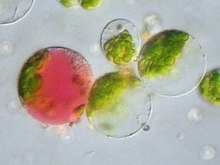Protoplast culture
The protoplast culture is a method of plant cell and tissue culture in biotechnology laboratories working.
The macromolecules of the cell walls of isolated single cells are enzymatically removed by hydrolysis in order to obtain naked cells. To avoid lysis of the cells, the cultures are prepared in a hypertonic solution.
The method was used to investigate and elucidate the processes involved in cell wall regeneration and cell wall structures. The transport of nutrients through the plasmalemma without the influence of the cell wall was also investigated in protoplast cultures. Working with this system is primarily aimed at generating interspecies hybridizations (e.g. Tomoffel ) which cannot be reached sexually. Intact, fertile plants can be produced from the protoplasts thus generated by protoplast fusion via somatic embryogenesis . In addition to plant regeneration, the protoplasts can also be transformed to create transgenic plants.
Individual evidence
- ↑ Shillito, RD, GK Carswell, et al. (1989). "REGENERATION OF FERTILE PLANTS FROM PROTOPLASTS OF ELITE INBRED MAIZE." Bio-Technology 7 (6): 581-587.
- ↑ Wang, AS, RA Evans, et al. (2000). "A mannose selection system for production of fertile transgenic maize plants from protoplasts." Plant Cell Reports 19 (7): 654-660.
literature
- KH Neumann: Plant cell and tissue cultures. An introduction . Ulmer Verlag, Stuttgart 1995, ISBN 3-8001-2689-3 , (UTB 1869).
